Learn how to make this authentic Panang Curry Paste recipe from scratch! Full of fragrant herbs and warm toasted spices, this Thai curry paste is way better than store bought.
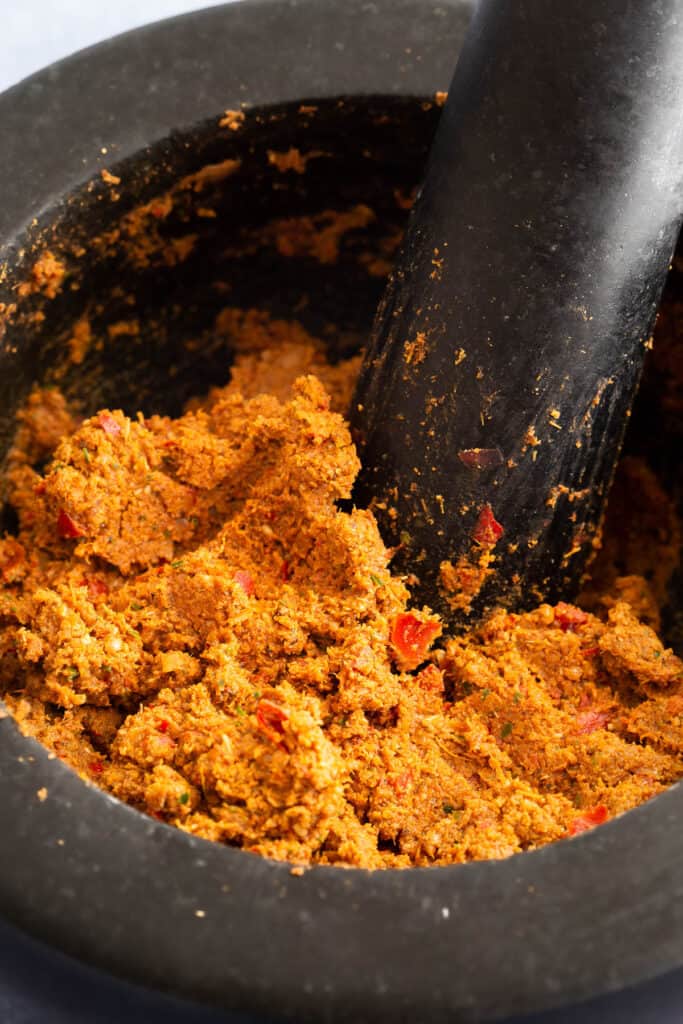
Why We Love This
While using the mortar and pestle does take a little more effort than unscrewing the lid off a jar – about 30-40 minutes worth if we’re honest – but despite the ‘effort’, it’s actually really easy to make your very own paste at home.
We recommend throwing a curry party! Go in together with ingredients and make your friends or family earn their dinner! Make a huge batch so everyone can take home a portion!
Related: Panang Chicken Curry / Thai Green Curry Paste / Thai Green Chicken Curry
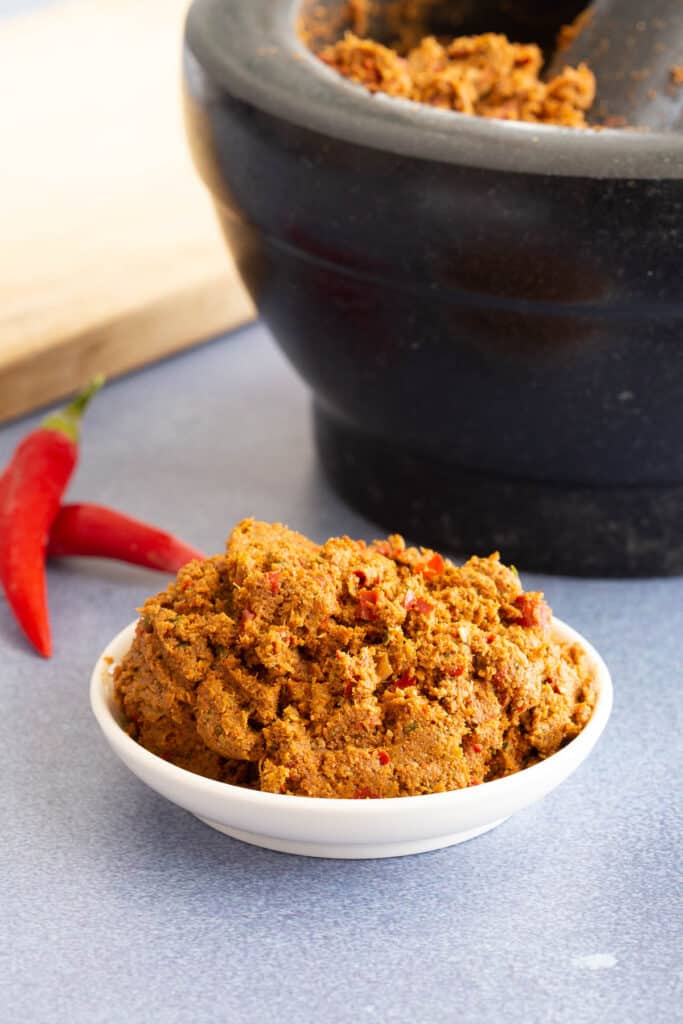
What is Panang Curry Paste?
Panang curry paste (also written as penang, phanang or phanaeng) is said to have originated in central Thailand, with some influences from Indian and Khmer cuisines.
Panang curry flavours are like a combination of red curry and peanut satay blended together. The panang curry paste includes a few classic Thai ingredients like lemongrass, galangal, shrimp paste and makrut / kaffir lime, which along with the crushed peanuts, give it a unique flavour compared to other curries.
Real authentic homemade curry pastes are so much better because:
- You control what you put in – real ingredients, fresh herbs and spices make all the difference. Pre-made pastes will always be inferior, requiring stabilisers and sometimes preservatives to made them last on the shelves.
- You control the spice – love the heat? Up the chillies! Be sure to throw in a few extra colourful birds eye chillies for that kick you’ve been waiting for. But if you don’t want to risk a burnt tongue, play it cool and tone it down. So simple!
- You can make up a big batch and store for later use. Then get ready as you turn it into classic Thai Chicken Panang Curry!
Our Top 3 Store Bought Panang Curry Pastes
If you can’t source the ingredients or substitutions for this recipe, you can always source store bought. Here’s our top 3 favourite brands we recommend:
Mae Ploy Panang Curry Paste
For big curry lovers, Mae Ploy’s Panang Curry Paste has enough for 4 batches! (Or more if you like a little less spice.)
Maesri Thai Panang Curry
The perfect one portion tin, these store well in the pantry so they’re ready when you need them most. Maesri is a great brand to have on hand.
Aroy-D Panang Curry Paste
Aroy-D Panang Curry Paste come in both these handy small 50g serves, or you can buy a big tub like the Mae Ploy if you can get your hands on it.
What You’ll Need
- Chillies – You want a combination of dried long chillies and small dried chillies for your paste. Fresh chillies also works depending on the availability in your area.
- Thai Mukrut / Kaffir Lime – Fresh leaves are best for this recipe. You can also find them dried, frozen or in a jar at Asian and local supermarkets. Sub with the zest of one lime. They may be labelled as kaffir lime, makrut or Thai lime leaves. The best name to use is makrut.
- Spices – What a gorgeous mix of spices used in this dish. This is the heart of the recipe, alongside the peanuts and chilli. Most spices will be available at the supermarket nowadays, or head to your Asian grocery store.
- Crushed Peanuts – Go for unsalted crushes peanuts – these will sometimes be in the baking section in the supermarket, or at an Asian grocer. You can also buy whole peanuts and crush them yourself. Sub with cashews for a creamier, lighter nutty result.
- Shrimp Paste – The umami addition to your curry paste. This will be a little smelly like fish sauce, but we guarantee it will bring the right flavour tones to the dish. Sub with fish sauce, or if you’re vegan use salt instead.
- Galangal – This is a very hard root spice. Try to find the lightest colour, or youngest as it’s much easier to cut and less fibrous. Find them fresh at your local Asian grocer and use a large cleaver or very sharp knife to help cut it finely. Sub with ginger in a pinch, although this is a different flavour.
- Garlic – Use fresh garlic instead of minced, this will bring a load of flavour to the final curry paste.
- Lemongrass – You can find whole and chopped lemongrass at most Asian and local supermarkets. Sub with the zest of one lemon per lemongrass stick, note this will give you a different flavour.
- Coriander Roots – You’ll usually find fresh coriander root in the bunches at your local Asian grocer or market. If you can’t find them, sub with the stems and a few leaves. Make sure to give them a good wash before chopping!
- Shallots – Shallots are now available at most supermarkets. Sub with regular red onion in a pinch.
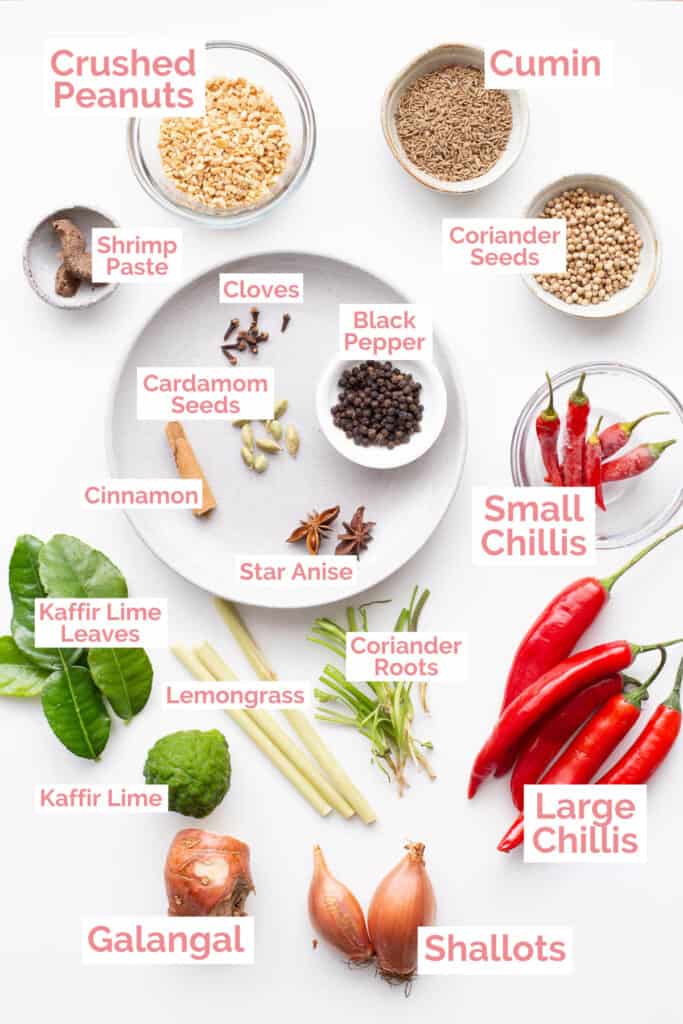
How to make Thai Panang Curry Paste:
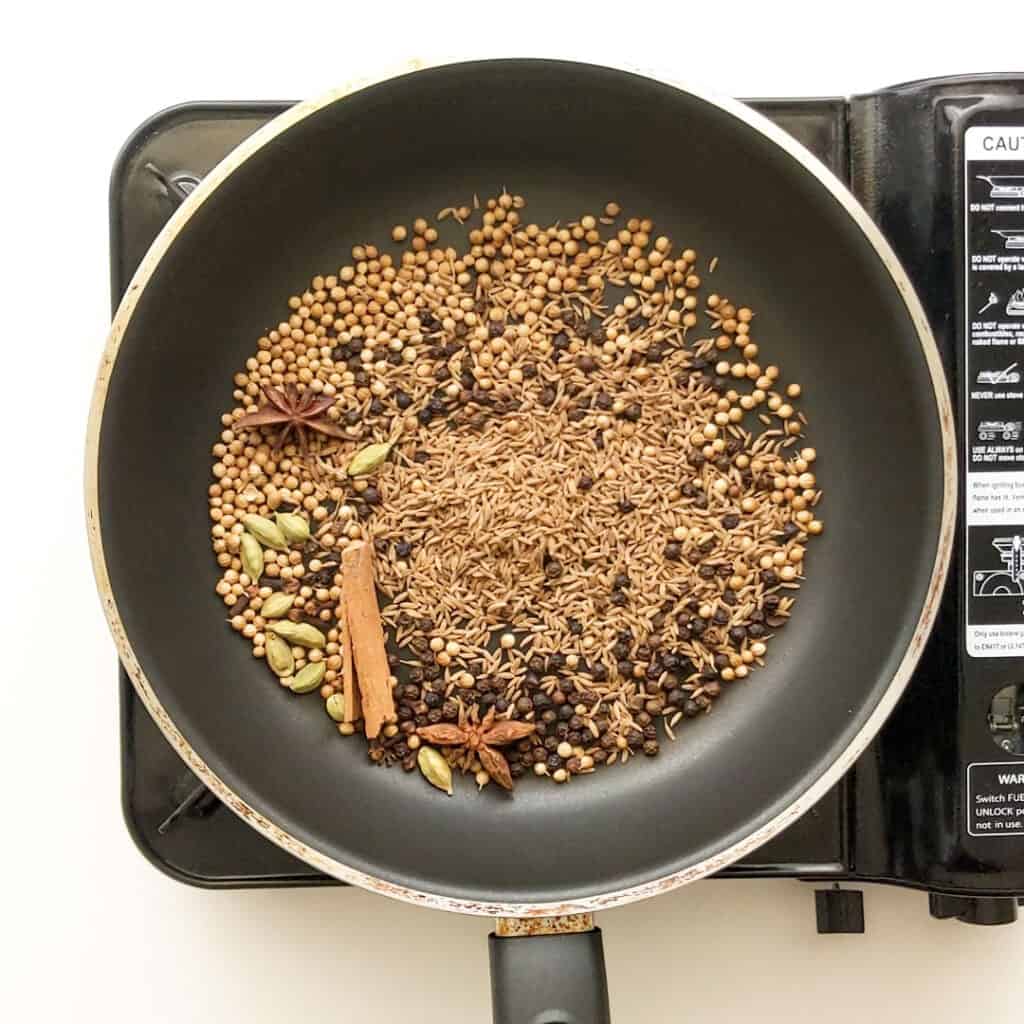
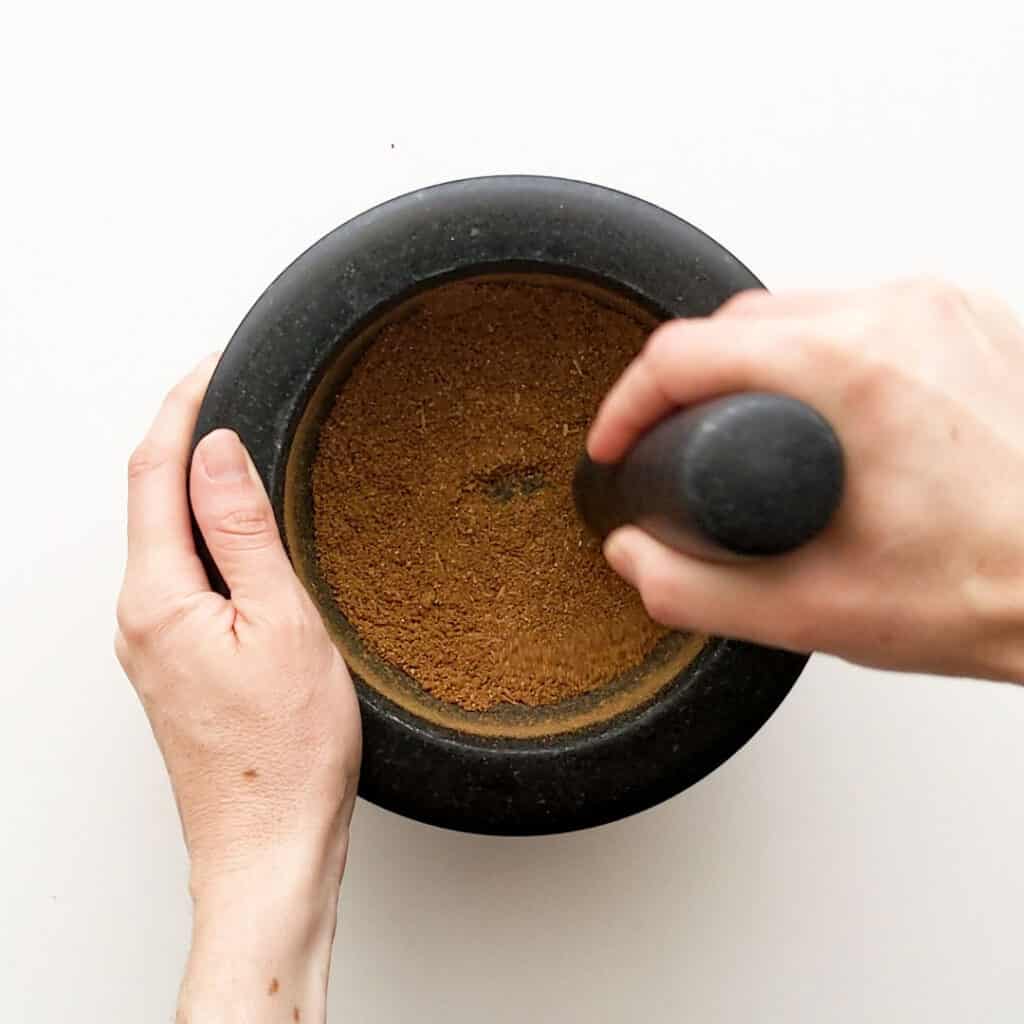
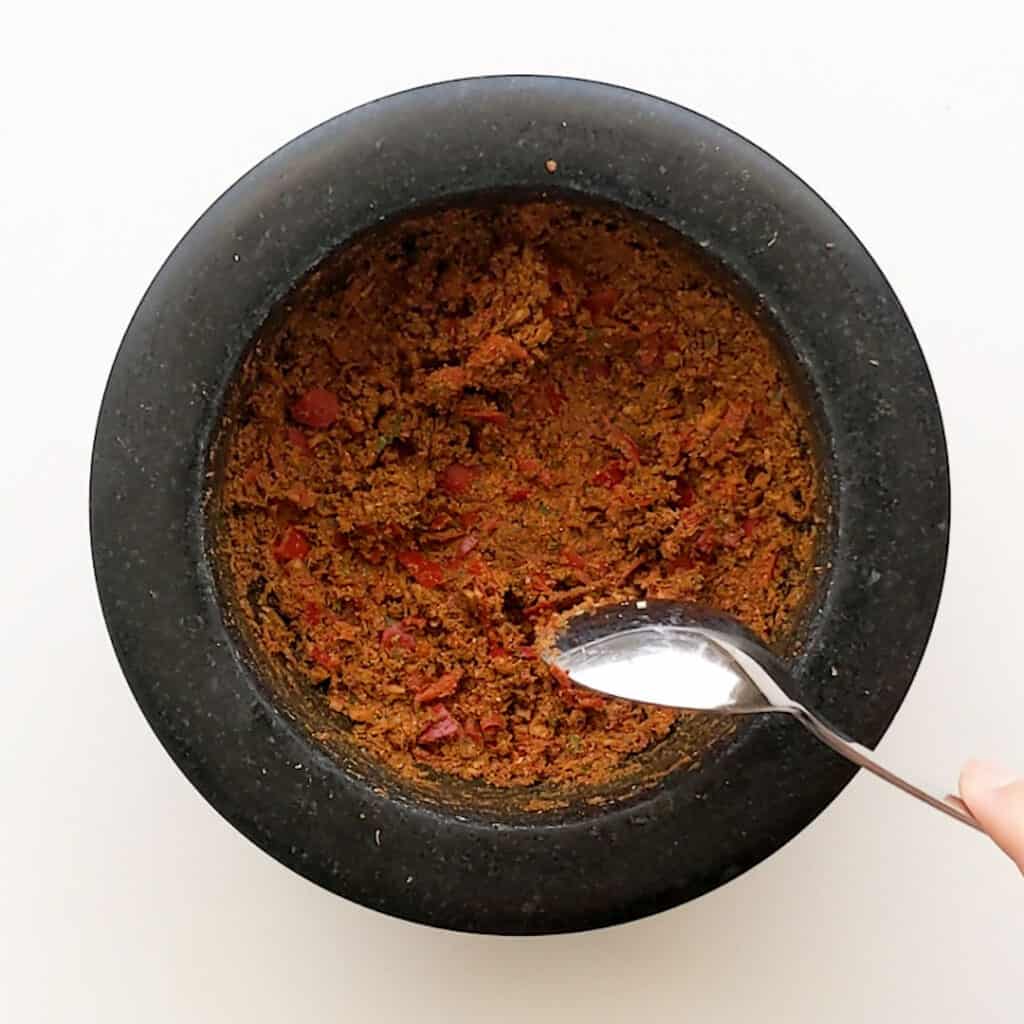
- Slice the top off large and small chillies and remove the seeds. If using fresh chilli: chop finely. If using dried chilli: Slice into small rings and soak in water for 40 mins to soften. Drain and squeeze out all the liquid (use gloves to avoid getting spicy chilli on yourself). Chop finely and set aside.
- In a medium frying pan, gently toast all spices over a low to medium heat for a 1-2 minutes, starting with the biggest and gradually adding in the others, through to the smallest. Order should be cinnamon, star anise, cardamom pods, cloves, coriander seeds, whole black pepper seeds and finally cumin seeds.
- Place all the toasted spices in a stone mortar and pestle, grind into a fine powder. Remove from mortar and pestle and set aside. Note: You can speed things up and use a spice grinder here, but a mortar will give you the best result.
- Add the remaining ingredients in the mortar and pestle – in sequence so that the most fibrous ingredients are added first – lemongrass, galangal (or ginger), kaffir lime rind, kaffir lime leaves, soaked large dried chillies (or fresh), soaked small dried chillies (or fresh), crushed peanuts, coriander root, shallots, garlic and finally shrimp paste. This will help you to achieve a smooth consistency. Note: You can speed things up and use a food processor here, but a mortar will give you the best result. If using a processor, you may need to add a little vegetable oil to help everything mix.
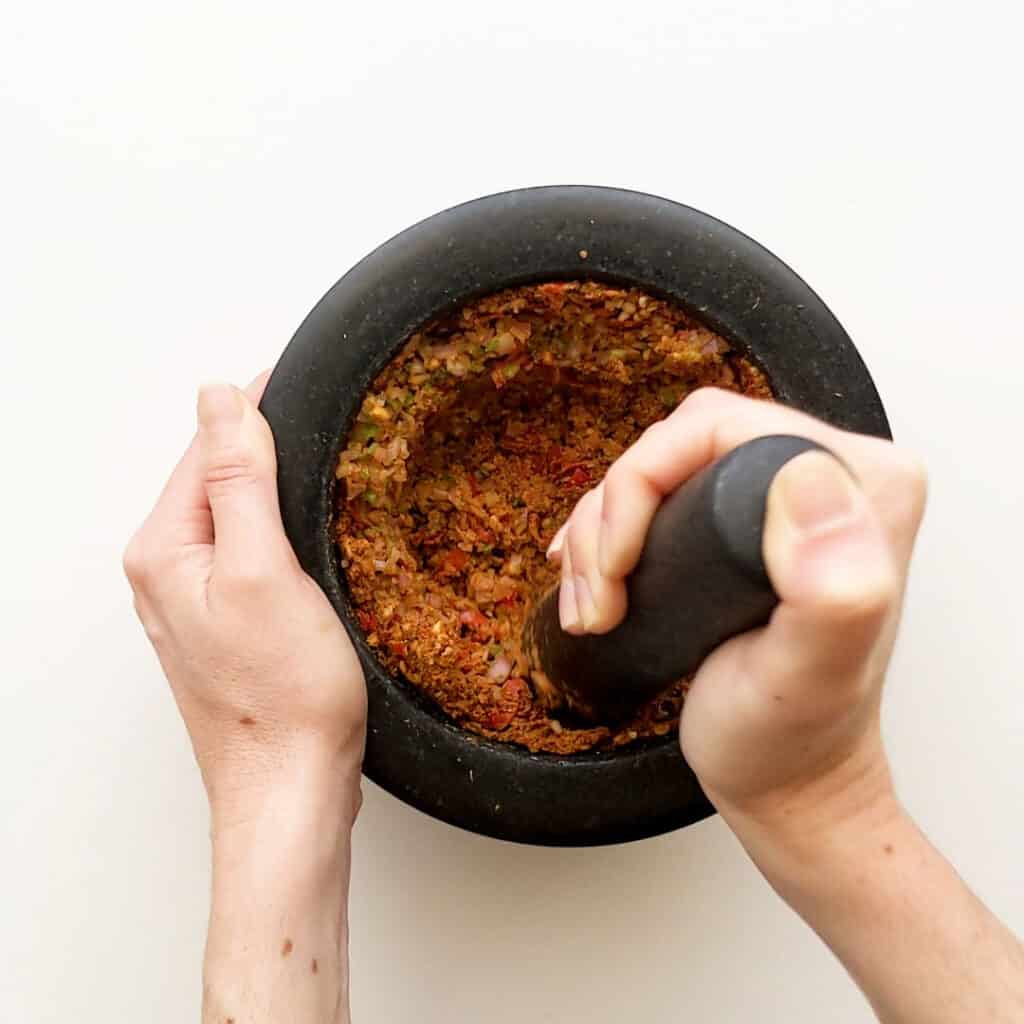
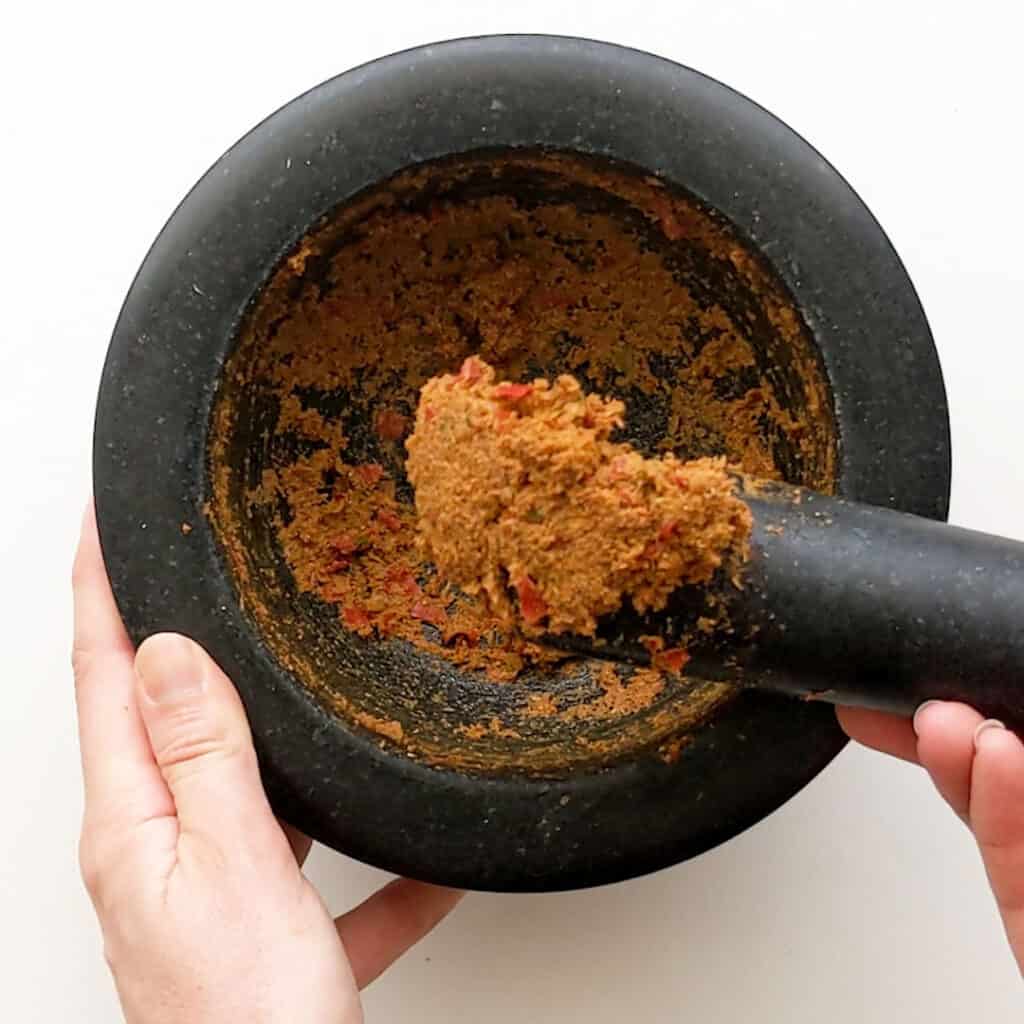
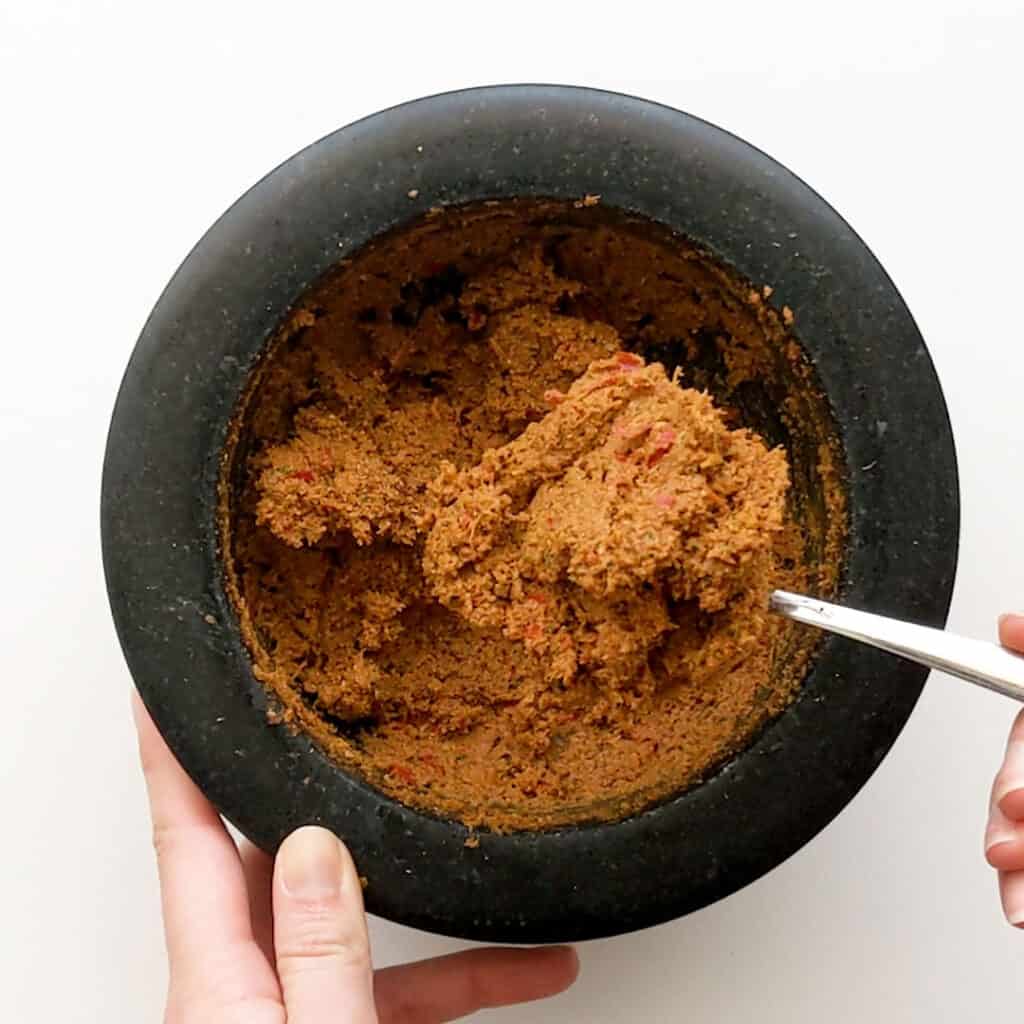
- Use a spoon to scrape the ingredients from the side of the mortar and pestle down to the centre as you go.
- Tip: If you have a small pestle, break up the mix into portions to make it easier when grinding the paste together.
- Finally add the spice powder and continue to pound until you obtain a smooth paste.
Wandercook’s Tips
- Storage – Place paste in ice cube trays, seal up in a plastic bag and freeze overnight. The next day, pop out the cubes and place in an airtight container. Homemade curry paste will last up to 6 months in the freezer (or up to about two weeks in the fridge).
- Toast Your Spices before Grinding – This helps release all the fragrant potential of the spices. Start with the biggest, like star anise and cinnamon, then work your way through to the smallest.
- Chop Finely – Chopping all your fresh herbs and chillies as finely as possible before popping them in the mortar and pestle will make things SO much easier. That way you’ll end up with a creamy smooth-textured paste at the end with half the work.
- Sit With Your Mortar & Pestle – Place your mortar on the floor and sit cross legged beside it. Yep! This will give you maximum power and assistance from gravity. Grab your pestle and hold it with your thumb pressed on the top. Then bang away, letting the pestle fall with a flick of your wrist. You actually need less effort here than you think – just let gravity do all the work for you! Meanwhile use a spoon to scoop the ingredients back down into the centre well of the mortar.
FAQs
Yes. When made from scratch with fresh ingredients, panang curry paste is gluten free.
This authentic panang curry recipe is not vegan as it includes shrimp paste. However, if you substitute shrimp paste with 1 tsp of salt you can make a vegan version.
Dried chillies is best and will give you a richer colour and more earthy flavour. If you can’t source dried, it’s fine to substitute with fresh chillies.
While traditionally Panang Curry Paste is made in a mortar and pestle, you can use a spice grinder and food processor to save on time. The end result won’t be exactly the same, but will be very close!
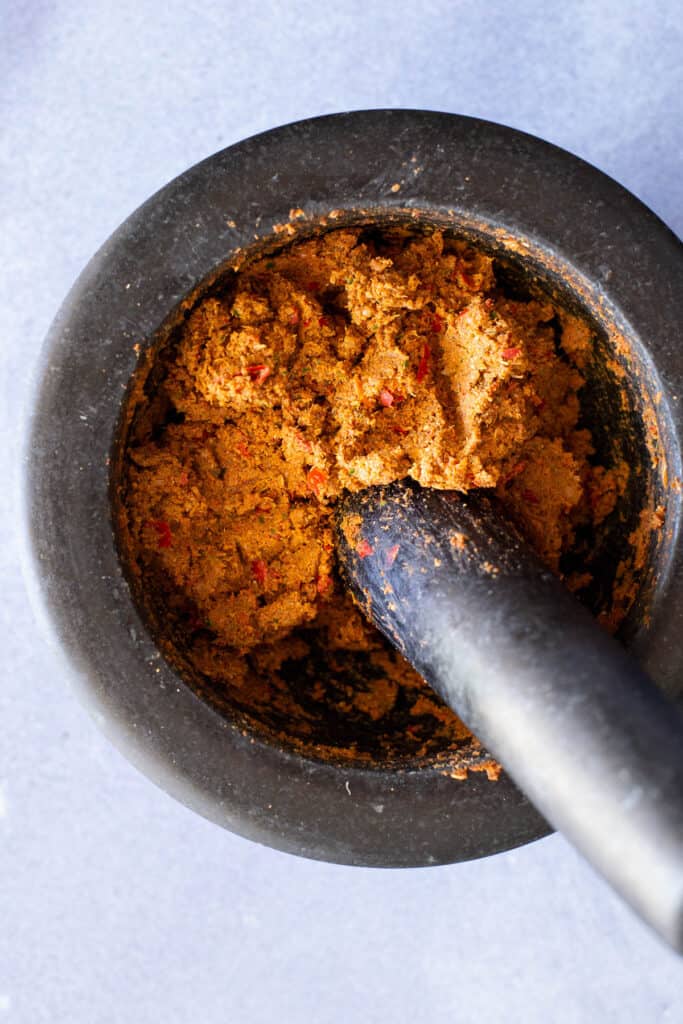
Spice up the kitchen and make these curries next:
★ Did you make this recipe? Please leave a comment and a star rating below!
Equipment
Ingredients
Spices
- 1 cinnamon stick
- 2 star anise
- 10 cardamom shells removed, or substitute with regular cardamom pods
- 10 whole cloves
- 2 tbsp coriander seeds
- 1 tbsp black peppercorns
- 2 tbsp cumin seeds
Other Ingredients
- 3 stems lemongrass finely sliced – or substitute with 3 tbsp jarred/sliced lemongrass
- 2.5 cm galangal or substitute with ginger
- 2 tsp Thai makrut / kaffir lime fruit rind finely chopped – or substitute with lemon or lime rind
- 6 Thai makrut / kaffir lime leaves finely sliced – or substitute with dried kaffir lime leaves
- 10 large dried red chillis soaked as per below, sub with half the amount for fresh chillies.
- 10 dried red thai chillis soaked as per below, sub with half the amount for fresh chillies.
- 4 coriander root chopped – or substitute with 2x fresh coriander stems
- 5 tbsp crushed peanuts
- 5 shallots finely chopped
- 10 cloves garlic finely chopped
- 1 tbsp Thai shrimp paste or substitute with anchovy paste (or 1 tsp salt for a vegan curry paste)
Instructions
- Slice the top off large and small chillies and remove the seeds. If using fresh chilli: chop finely. If using dried chilli: Slice into small rings and soak in water for 40 mins to soften. Drain and squeeze out all the liquid (use gloves to avoid getting spicy chilli on yourself). Chop finely and set aside.10 large dried red chillis, 10 dried red thai chillis
- In a medium frying pan, gently toast all spices over a low to medium heat for a 1-2 minutes, starting with the biggest and gradually adding in the others, through to the smallest. Order should be cinnamon, star anise, cardamom pods, cloves, coriander seeds, whole black pepper seeds and finally cumin seeds.1 cinnamon stick, 2 star anise, 10 cardamom, 10 whole cloves, 2 tbsp coriander seeds, 1 tbsp black peppercorns, 2 tbsp cumin seeds
- Place all the toasted spices in a stone mortar and pestle, grind into a fine powder. Remove from mortar and pestle and set aside. Note: You can speed things up and use a spice grinder here, but a mortar will give you the best result.
- Add the remaining ingredients in the mortar and pestle – in sequence so that the most fibrous ingredients are added first – lemongrass, galangal (or ginger), kaffir lime rind, kaffir lime leaves, soaked large dried chillies (or fresh), soaked small dried chillies (or fresh), crushed peanuts, coriander root, shallots, garlic and finally shrimp paste. This will help you to achieve a smooth consistency. Note: You can speed things up and use a food processor here, but a mortar will give you the best result. If using a processor, you may need to add a little vegetable oil to help everything mix.2 tbsp coriander seeds, 3 stems lemongrass, 2.5 cm galangal, 2 tsp Thai makrut / kaffir lime fruit rind, 6 Thai makrut / kaffir lime leaves, 10 large dried red chillis, 10 dried red thai chillis, 4 coriander root, 5 tbsp crushed peanuts, 5 shallots, 10 cloves garlic, 1 tbsp Thai shrimp paste
- Use a spoon to scrape the ingredients from the side of the mortar and pestle down to the centre as you go. Tip: If you have a small pestle, break up the mix into portions to make it easier when grinding the paste together.
- Finally add the spice powder and continue to pound until you obtain a smooth paste.
Video
Recipe Notes
- Chillies – Fresh chillies also works.
- Thai Mukrut / Kaffir Lime – Fresh leaves are best for this recipe. You can also find them dried, frozen or in a jar at Asian and local supermarkets. Sub with the zest of one lime. They may be labelled as kaffir lime, makrut or Thai lime leaves. The best name to use is makrut.
- Spices – Most spices will be available at the supermarket nowadays, or head to your Asian grocery store.
- Crushed Peanuts – Go for unsalted crushes peanuts – these will sometimes be in the baking section in the supermarket, or at an Asian grocer. You can also buy whole peanuts and crush them yourself. Sub with cashews for a creamier, lighter nutty result.
- Shrimp Paste – Sub with fish sauce, or if you’re vegan use salt instead.
- Galangal – This is a very hard root spice. Try to find the lightest colour, or youngest as it’s much easier to cut and less fibrous. Find them fresh at your local Asian grocer and use a large cleaver or very sharp knife to help cut it finely. Sub with ginger in a pinch, although this is a different flavour.
- Garlic – Use fresh garlic instead of minced.
- Lemongrass – You can find whole and chopped lemongrass at most Asian and local supermarkets. Sub with the zest of one lemon per lemongrass stick, note this will give you a different flavour.
- Coriander Roots – You’ll usually find fresh coriander root in the bunches at your local Asian grocer or market. If you can’t find them, sub with the stems and a few leaves. Make sure to give them a good wash before chopping!
- Storage – Place paste in ice cube trays, seal up in a plastic bag and freeze overnight. The next day, pop out the cubes and place in an airtight container. Homemade curry paste will last up to 6 months in the freezer (or up to about two weeks in the fridge).
- Chop Finely – Chopping all your fresh herbs and chillies as finely as possible before popping them in the mortar and pestle will make things SO much easier. That way you’ll end up with a creamy smooth-textured paste at the end with half the work.
- Sit With Your Mortar & Pestle – Place your mortar on the floor and sit cross legged beside it. Yep! This will give you maximum power and assistance from gravity. Grab your pestle and hold it with your thumb pressed on the top. Then bang away, letting the pestle fall with a flick of your wrist. You actually need less effort here than you think – just let gravity do all the work for you! Meanwhile use a spoon to scoop the ingredients back down into the centre well of the mortar.
Nutrition
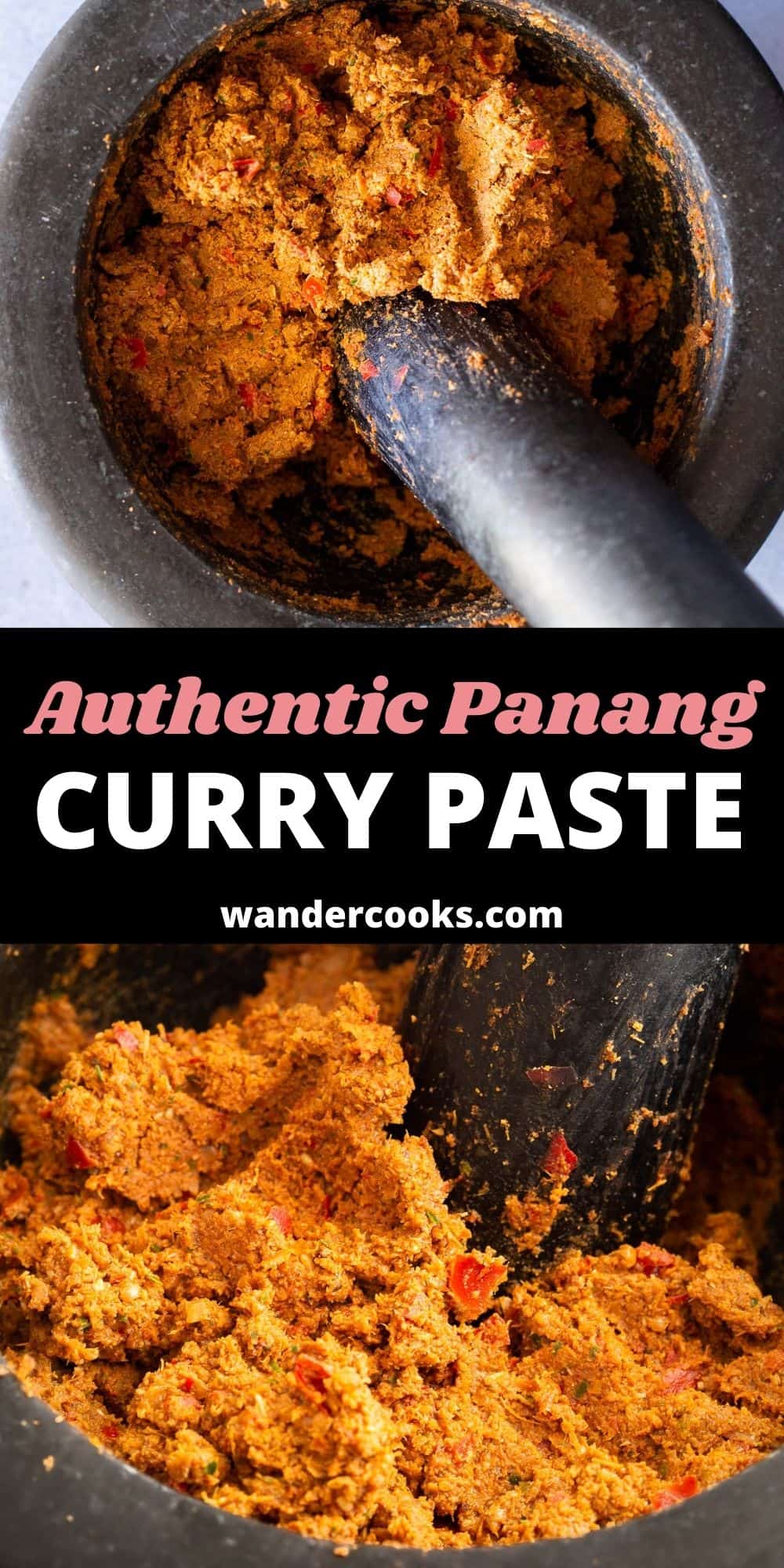

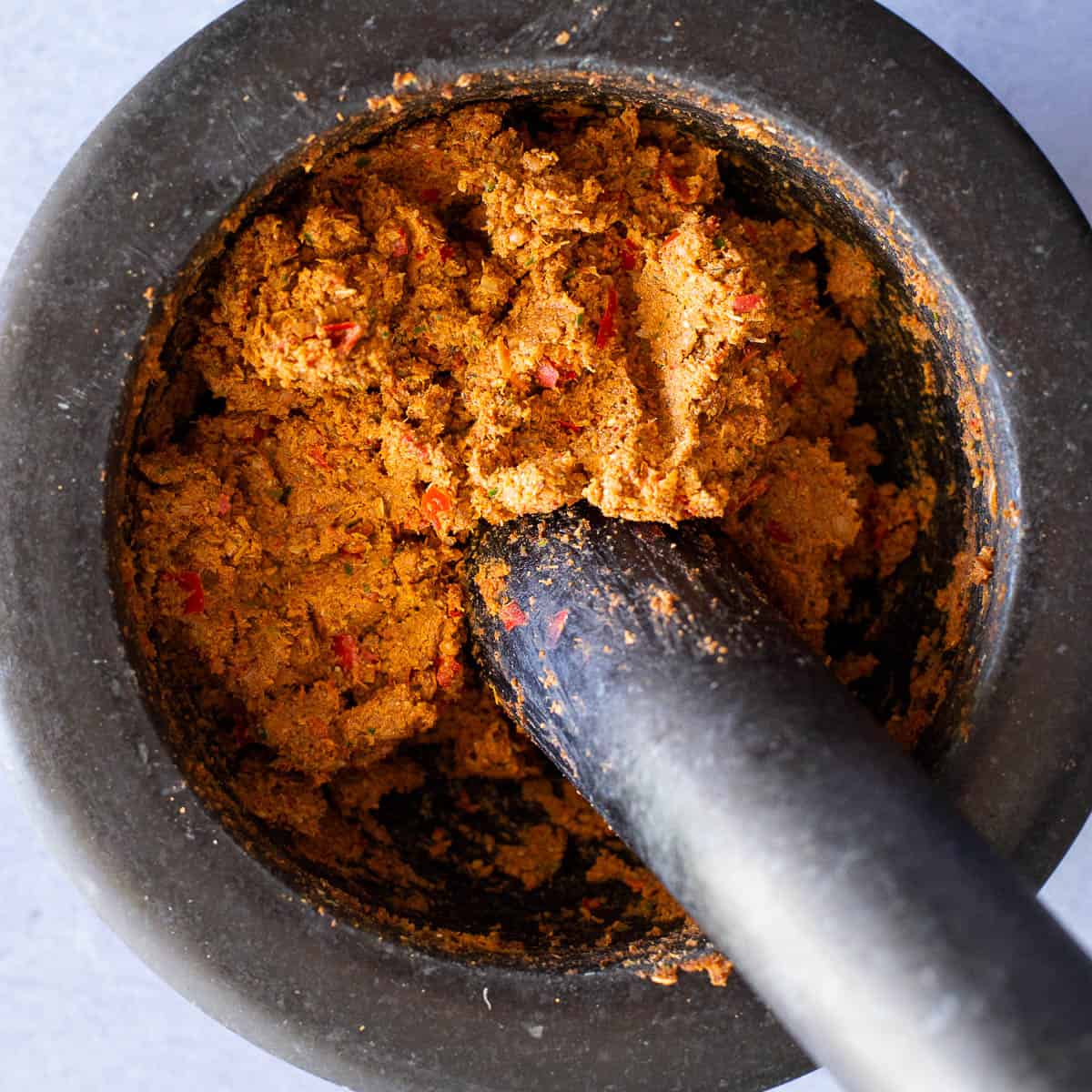


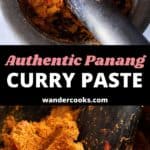
28 Comments
Julie Forrest
18/11/2022 at 12:29 amI haven’t tried the recipe yet but am wondering once you have the paste how much do you use to make the curry? Also are there any specifics on making the curry from the paste?
Wandercooks
18/11/2022 at 2:37 pmUse around 100 g / 2.5 oz of the curry paste. Then, just follow the instructions here for making the curry: https://www.wandercooks.com/chicken-thai-panang-curry/
Have fun!
Neil
02/03/2022 at 3:08 amGreat stuff here. The recipe I have differs a little on the spice side but I guess there are variants. Was suprised there is no fresh turmeric in your recipe though 🙂
Wandercooks
02/03/2022 at 11:53 amHey Neil, thanks for stopping by! No tumeric in this one, which is the Koh Lanta style variation. You can definitely add some in if you prefer it, as I’m sure that would lend a lovely layer of flavour to the mix. 🙂
Naomi
25/07/2021 at 1:11 amThe amount of coriander root listed is unclear – 4 what? Can you clarify?
Wandercooks
26/07/2021 at 5:01 pmHey Naomi! It’s 4 coriander roots – each little bunch of coriander is connected to a single root, so you want to use 4 of them. 🙂
Kai Etringer
17/05/2020 at 9:52 amHi! I just made this and I’m gonna use it in a few days as a replacement for the penang paste in this one https://rasamalaysia.com/thai-panang-curry-with-beef/
Wandercooks
18/05/2020 at 10:03 amHi Kai, I’d recommend starting with 2-3 tablespoons of our paste, then depending on your spice tolerance, you can add more and adjust from there as needed. Hope this helps, and have fun cooking! Let us know how it turns out.
kai etringer
18/05/2020 at 12:16 pmthank you so much!
Wandercooks
18/05/2020 at 4:37 pmYou’re very welcome! 🙂
Nikki
17/10/2019 at 4:37 pmI love the recipe. Can I know which mortar pestle you are using? I have been looking for a large-sized one for a long time.
Wandercooks
22/10/2019 at 11:19 amHey Nikki, this one was in Thailand, and we got our big one in Indonesia! Looking online, you can get a large 8 inch Mortar and Pestle on Amazon here. Hope that helps!
Alison
02/08/2019 at 7:33 pmYum! I love curry! I made the vegan version of this and it turned out great!
Wandercooks
06/08/2019 at 5:06 pmThat’s awesome Alison, thanks for trying it!
Tatiana
02/08/2019 at 4:38 pmThis recipe is SPECTACULAR!! It’s healthy, easy, and captures the flavors of Thai food in a way I haven’t encountered in most recipes. Thank you!
Wandercooks
06/08/2019 at 5:06 pmAww thanks Tatiana, means a lot. 🙂 Glad you enjoyed!
Dannii
02/08/2019 at 3:57 pmYou can’t beat homemamde curry paste. It just saves so much money too!
Wandercooks
06/08/2019 at 5:07 pmI knoooow, it’s so fun too!
Natalie
02/08/2019 at 3:10 pmLooks and sounds so delicious and authentic – can’t wait to try this recipe!
Wandercooks
06/08/2019 at 5:07 pmSo much flavour!
Kelly Anthony
02/08/2019 at 12:46 pmI love your idea of curry therapy and making a big batch to freeze for later. Such a great idea and everybody needs to a little curry therapy once in a while.
Wandercooks
06/08/2019 at 5:07 pmTotally agree haha, it’s a great way to use up some energy after a frustrating day and put it to delicious use!
Kelly
20/05/2019 at 4:57 amHello, for the 10 large dried red chillis soaked as per below, what is a large chilli? Is it like 10 large chilli de Arbol cause that seems like a lot. Do you have a measurement in grams?
For the 10 dried red birds eye chillis medium spice level soaked as per below I can only find dried powder and it’s extremely hot. Can you find these at a Thai market and it says medium heat? Do you know what brand you use for both chillis? Thanks!
Wandercooks
20/05/2019 at 7:42 pmHey Kelly – the chilli used can be completely up to the cook! We get ours from the Asian grocer for both the large chillis and dried bird’s eye. The label on our large chilli literally just says “dried large chilli”. The size is about 10cm long or more. The large chilli pack’s more flavour than heat, but you can put in less if you don’t want it too hot. Same with the bird’s eye chilli – put in as many or as little as you like. It’s up to the individual. You can replace dried and soaked bird’s eye chilli with – the rule of thumb is 1 bird’s eye chilli = 1/2 teaspoon of chilli powder. Hope this helps!
Lee
06/01/2017 at 4:35 amHi, thanks for the recipe but where is the shrimp paste and nuts used in making the paste? There listed in the ingredients needed but they are not mentioned in the recipe
Wandercooks
06/01/2017 at 9:00 amHey Lee, thanks for getting in touch! When assembling all the ingredients in the mortar and pestle add them in the same order as per the ingredients list. I’ve updated the recipe to make this a little clearer. Best of luck and enjoy your freshly made curry paste! 🙂
Linz
04/05/2016 at 9:55 amWhat exactly is coriander root? Where can you find it and can you substitute coriander powder? Also, where did you find kaffir lime leaves and the rind, were they dried? I’ve never seen them in grocery stores here in the states?
Thanks for posting, can’t wait to try it! 🙂
Btw, some of the tips are the same things my South Indian mom would do when making masala for a curry!
Wandercooks
04/05/2016 at 10:28 amThat’s awesome Linz! Great to hear your mum has the same tips – they’re great aren’t they! Thanks for getting in touch.
We’ve had a browse around the web and you can use coriander powder, or you can even get cheap coriander root powder on Amazon here – Coriander Root Powder and the Kaffir Lime Leaves here – Fresh Kaffir Lime Leaves
and the Kaffir Lime Leaves here – Fresh Kaffir Lime Leaves  . For the actual fruit, we only JUST found them where we live in a little Asian grocer – so we suggest trying one of those first, and if you can’t find them, regular lime rind will substitute fine.
. For the actual fruit, we only JUST found them where we live in a little Asian grocer – so we suggest trying one of those first, and if you can’t find them, regular lime rind will substitute fine.
Let us know how you go sourcing the ingredients and if you need any other help. 🙂